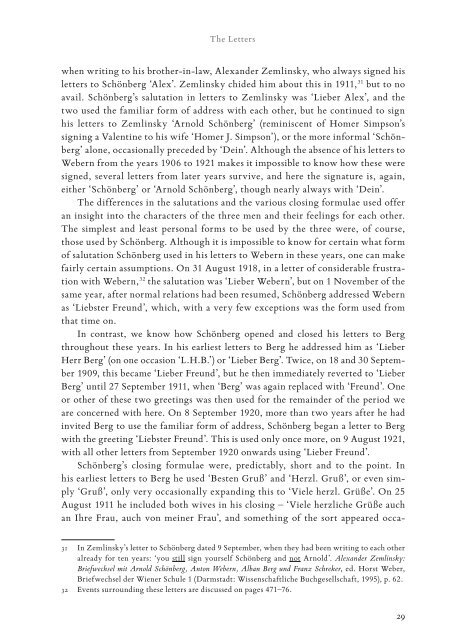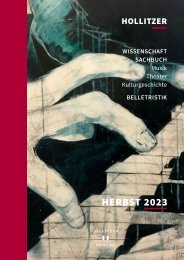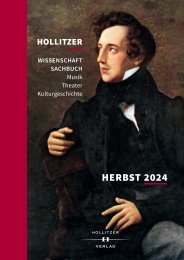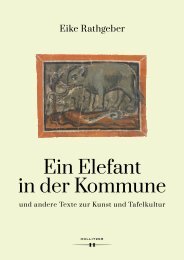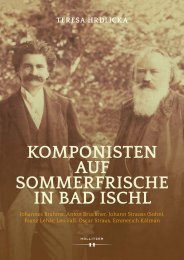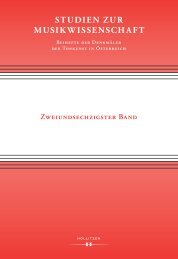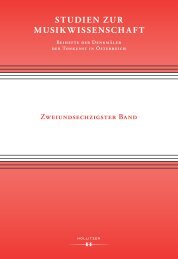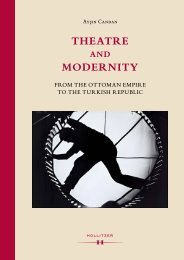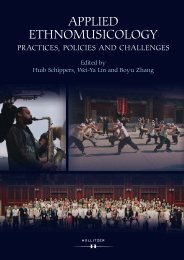Leseprobe_Three Men of Letters
Create successful ePaper yourself
Turn your PDF publications into a flip-book with our unique Google optimized e-Paper software.
The <strong>Letters</strong><br />
when writing to his brother-in-law, Alexander Zemlinsky, who always signed his<br />
letters to Schönberg ‘Alex’. Zemlinsky chided him about this in 1911, 31 but to no<br />
avail. Schönberg’s salutation in letters to Zemlinsky was ‘Lieber Alex’, and the<br />
two used the familiar form <strong>of</strong> address with each other, but he continued to sign<br />
his letters to Zemlinsky ‘Arnold Schönberg’ (reminiscent <strong>of</strong> Homer Simpson’s<br />
signing a Valentine to his wife ‘Homer J. Simpson’), or the more informal ‘Schönberg’<br />
alone, occasionally preceded by ‘Dein’. Although the absence <strong>of</strong> his letters to<br />
Webern from the years 1906 to 1921 makes it impossible to know how these were<br />
signed, several letters from later years survive, and here the signature is, again,<br />
either ‘Schönberg’ or ‘Arnold Schönberg’, though nearly always with ‘Dein’.<br />
The differences in the salutations and the various closing formulae used <strong>of</strong>fer<br />
an insight into the characters <strong>of</strong> the three men and their feelings for each other.<br />
The simplest and least personal forms to be used by the three were, <strong>of</strong> course,<br />
those used by Schönberg. Although it is impossible to know for certain what form<br />
<strong>of</strong> salutation Schönberg used in his letters to Webern in these years, one can make<br />
fairly certain assumptions. On 31 August 1918, in a letter <strong>of</strong> considerable frustration<br />
with Webern, 32 the salutation was ‘Lieber Webern’, but on 1 November <strong>of</strong> the<br />
same year, after normal relations had been resumed, Schönberg addressed Webern<br />
as ‘Liebster Freund’, which, with a very few exceptions was the form used from<br />
that time on.<br />
In contrast, we know how Schönberg opened and closed his letters to Berg<br />
throughout these years. In his earliest letters to Berg he addressed him as ‘Lieber<br />
Herr Berg’ (on one occasion ‘L.H.B.’) or ‘Lieber Berg’. Twice, on 18 and 30 September<br />
1909, this became ‘Lieber Freund’, but he then immediately reverted to ‘Lieber<br />
Berg’ until 27 September 1911, when ‘Berg’ was again replaced with ‘Freund’. One<br />
or other <strong>of</strong> these two greetings was then used for the remainder <strong>of</strong> the period we<br />
are concerned with here. On 8 September 1920, more than two years after he had<br />
invited Berg to use the familiar form <strong>of</strong> address, Schönberg began a letter to Berg<br />
with the greeting ‘Liebster Freund’. This is used only once more, on 9 August 1921,<br />
with all other letters from September 1920 onwards using ‘Lieber Freund’.<br />
Schönberg’s closing formulae were, predictably, short and to the point. In<br />
his earliest letters to Berg he used ‘Besten Gruß’ and ‘Herzl. Gruß’, or even simply<br />
‘Gruß’, only very occasionally expanding this to ‘Viele herzl. Grüße’. On 25<br />
August 1911 he included both wives in his closing – ‘Viele herzliche Grüße auch<br />
an Ihre Frau, auch von meiner Frau’, and something <strong>of</strong> the sort appeared occa-<br />
31 In Zemlinsky’s letter to Schönberg dated 9 September, when they had been writing to each other<br />
already for ten years: ‘you still sign yourself Schönberg and not Arnold’. Alexander Zemlinsky:<br />
Briefwechsel mit Arnold Schönberg, Anton Webern, Alban Berg und Franz Schreker, ed. Horst Weber,<br />
Briefwechsel der Wiener Schule 1 (Darmstadt: Wissenschaftliche Buchgesellschaft, 1995), p. 62.<br />
32 Events surrounding these letters are discussed on pages 471–76.<br />
29


